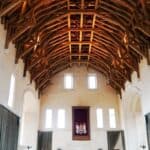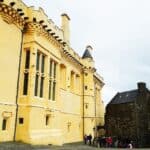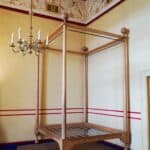The History of Stirling Castle and a Guide to Visiting
Stirling Castle is one of the largest and most important castles in Scotland. Several Scottish Kings and Queens have been crowned at Stirling, including Mary, Queen of Scots in 1542. Frequently used as the Scottish royal residence, before the union with England. Sitting atop Castle Hill, it is surrounded on three sides by steep cliffs, providing a strong defensive position as well as a lovely view. Get ready to learn a whole lot of Stirling Castle history. As well as how you can visit and tour the castle!
How to Visit Stirling Castle
I took the train to Stirling Station from Glasgow. It is on Goosecroft Road near the city centre. I walked the rest of the way to the castle, it’s a bit of a ways so you can also take a bus or taxi. To get the most of your trip, I’d recommend taking one of the Stirling Castle tours. The guided tours are complimentary! Not only to they regale you with information about Stirling Castle’s history, but about Scotland’s history as well. The tour guide I got was extremely friendly, knowledgeable, and passionate about the castle. He engaged with us and encouraged questions. It’s wonderful when you get an excellent guide! Included in the ticket prices is the Stirling Castle tour, taking place on the hour between 10am and 5pm.
Other Stirling Castle Tours
If guided tours aren’t for you, though I highly recommend it, check out the audio guides which are available in a variety of languages for an additional charge. It is free for Historic Scotland Members. If you’re visiting Stirling Castle with children, they have a special Stirling Castle tour called the History Hunter tour. Specially designed for children 5-12, though other ages are welcome. Hear tales about William Wallace, Mary Queen of Scots, how a cannonball should be fired, and the best way to storm a castle. History Hunter tours are every Saturday at 2pm. They also have sign language tours on select dates.
If you’re interested in William Wallace, and why wouldn’t you be, you can visit the National Wallace Monument. You can actually see it from the castle! I ran out of time so didn’t get the opportunity myself, but would if I get to visit again!
Mary Queen of Scots Castle
Mary Queen of Scots was crowned in the chapel royal on September 9th, 1543. She was also brought up here at Stirling Castle, until she was sent to Inchmahome Priory, and then to France in 1548. If you’ve seen the first episode of Reign, you would have seen her move from the Priory to France.
Queen Mary returned to Scotland in 1561, and visited Stirling Castle frequently. A replica costume showing the type of clothing that Mary wore is on display. She owned a lot of black, I assume because of the death of Francis and then the loss of her son. Mary was traveling from Stirling when she was abducted by the Earl of Bothwell, beginning the chain of events that led to her forced abdication and flight to England. As a result of her ties to the castle’s history, some know it as the Mary Queen of Scots castle.
The Old Chapel Royal
The old chapel royal was the scene of the baptism of James VI, Mary’s son, in 1566. She staged a three day event celebrating him. An elaborate feast was held in the Great Hall after the Catholic service. Later that night, Scotland’s first firework display took place over a mock ‘enchanted fort’ built on what is now the Esplanade. Talk about a party!
Seven months later, Mary was forced to give up her throne. In a Protestant ceremony, the one year old James VI was crowned at the Church of the Holy Rude in Stirling. Almost 30 years later, in 1594, the old chapel royal was replaced by one designed for the new faith.
Stirling Castle Great Hall
The Stirling Castle Great Hall is the largest and finest medieval hall in Scotland. Up to 500 people could meet here for state banquets and sessions of parliament. Built in 1503, the Great Hall proclaimed the power of James IV and the Stewart monarchy. Probably the most extravagant event was a feast to celebrate the baptism of James VI’s son, Henry, in 1594. In order to serve the fish course, a fully-rigged, 5m-long ship with 36 brass guns was wheeled in. Do you think he felt the need to top his own baptism?
Fun Fact: The unicorn is the national animal of Scotland. That’s why you can see a number of them around the castle. The Royal Coat of Arms of Scotland, used prior to 1603 by the Kings of Scotland was supported by two unicorns. The current royal coat of arms of the United Kingdom is supported by a unicorn for Scotland and a lion for England.
Stirling Castle History of Kings
In 1496 James VI chose the castle’s highest point for his private residence. The turreted staircase, now the entrance to the regimental museum, originally climbed to James’ apartment. The King’s Old Building endured 500 years of alterations, including when the army moved in during the 1600s and the northern end rebuild after a fire in 1855.
Only people with some social standing were allowed into this room to wait for a possible audience with the king. Deciding who might be given the privilege was his staff. The chosen few were invited to enter the King’s Inner Hall.
Onto the King’s Bedchamber, where only the most important visitors and personal friends met the king. Can you once again see the unicorn, a royal symbol of purity and strength, in the bedroom. The monarch probably dressed, washed and prayed here, while sleeping in a small room nearby.
The Stirling Heads
If you looked up, you would see an intricate ceiling decorated with a series of carved portraits. Originally decorated with oak portrait roundels known as the Stirling Heads. Described as “among the finest examples of Scottish Renaissance wood-carving now extant.” The carvings were taken down following a ceiling collapse in 1777. Of an estimated 56 original heads, 38 survive.
Some of the portraits are believed to be of kings, queens, and courtiers. Others are thought to show classical or Biblical figures. A £12 million project began to recreate the grandeur of the Royal Palace. It took a decade of research and craftsmanship to restore the castle. Thru it six royal apartments were restored to how they would have looked in the 1540s, when this was the childhood home of Mary Queen of Scots.
The Queen’s Rooms at the Royal Palace
Reserved for the queen and her most important visitors was the Queen’s Bedchamber. In the Queen’s Inner Hall, guests were granted a chance to meet the queen. The stools and benches were for her ladies in waiting. The newly painted ceiling included portraits of James and Mary, though it may have once have been covered with carved heads like the King’s.
As part of the project, seven hand-woven tapestries were restored. They hang on the walls of the Queen’s Inner Hall in the royal palace. Closely based on the Hunt of the Unicorn series which were created in the early 1500s and are now in the Metropolitan Museum of New York. Only the very wealthiest of people could afford tapestries. James V had a large collection of them, including two sets which showed unicorns.
How to Dress Like a Queen or King
The Queen Wears:
- A fashionable French-style gown, made of black velvet, from the Italian city of Lucca
- Underneath her gown, a kirtle, or underskirt, made of crimson satin from Venice
- Beneath her kirtle, a smock, like a shift dress, but no pants!
- A headdress stitched with precious stones, called a French hood
A King Wears:
- A gown of crimson satin, from Venice, lined with the finest fur
- A jerkin, or sleeveless coat, made from black satin and edged with gold braid
- A padded jacket, called a doublet, stitched with jewels and gold embroidery
- An embroidered shirt, poking out through the slashes in his doublet
- A floppy velvet bonnet with a beautiful gold and pearl brooch
Medieval Meals
When you visit Stirling Castle you’ll learn a TON about the medieval diet! There is an elaborate kitchen section dedicated to just that! In the reconstructed great kitchens, every detail was informed by research. An English traveller noted in the 16th century that the Scots, ‘nauseate the very air with their tainted breath, so perfumed with onions, that to an Englishman it is almost infectious’.
The diet of the royal household was largely dependent on meat and, during Lent, on fish. Stirling Castle had its own garden which provided fresh vegetables, herbs, and fruit for the kitchens. The gardener received no pay if he was unable to produce sufficient amounts of fruit and vegetables. Talk about a tough job!
Eat Your Heart Out
By the 16th century it had become fashionable for food to be served in several courses. Generally dinner began with a type of soup dish known as pottage. Followed by roasts, small pies and pastries, then tarts or fritters. Ending with fresh or preserved fruit and sweetmeats.
16th century food was consumed on the basis of a social food chain. One table was served a far greater amount of food than was necessary, the extra would then be passed on to others by descending order of social rank. The king and queen ate first, followed by his or her courtiers, various officials, their personal servants, and finally those who served the food to the tables. The same system applied among the other servants.
A Scottish Pint of Ale
Everyone drank ale from morning till night in the 1500s. A servant working for the royal family was given a daily allowance of a joug of Scottish pint of ale (1.7 liters). To meet the household’s demand, it was regularly brewed here using bere, an old variety of barley. Often the work of women known as alewives.
Ale was consumed with every meal, even by children. Safer to drink than water or milk as any germs it may have contained were killed by the prolonged boiling of malt during the brewing process. It was also highly nutritious and constituted an important part of the medieval diet. Much of what was consumed was known as small beer, which had a low level of alcohol that acted as a preservative but was not intoxicating.
The North Gate
The North Gate is the oldest surviving part of Stirling Castle. Originally a gatehouse built in 1381 for King Robert II, grandson of Robert the Bruce and the first of the Stewart monarchs. A groove in the archway show where a portcullis was once lowered. It is unknown what the north gate’s upper floors originally looked like. In 1511-1512 when the building was expanded to provide kitchens for the great hall, the upper floors were removed.
The Birdman of Stirling
When John Damian declared he would fly to France dressed in a chicken suit, one day in 1507, James IV and his court crowded here to watch. The alchemist/courtier leapt from Stirling Castle’s battlements, flapped his wings and plummeted into a muck-heap below. He luckily survived with just a broken leg. Despite spending vast sums of the King’s money on unsuccessful experiments, the alchemist continued to flourish in the vibrant Renaissance culture of James IV’s court.
Stirling Castle Hours
The castle opens daily at 9.30am. Closing time vary by season so make sure to check before you visit Stirling Castle. For the summer, April 1 – September 30 the last entry is 5:15pm, closing at 6pm. For the winter, October 1 – March 31 the last entry is 4:15pm, closing at 5pm. The castle closes on the 25th and 26th of December. On January 1st they are open from 11am to 5pm. Closing times for independent museums vary. It is recommended that you allow at least 2 hours to see all the castle highlights.



















































